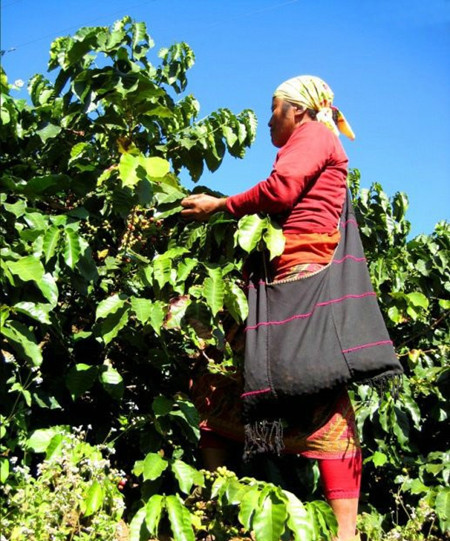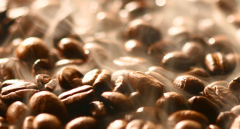Coffee planting techniques what coffee planting techniques are there? How do you grow coffee? How to grow coffee?

1. The cultivation of strong coffee seedlings 1. The choice of nursery land is close to the water source, convenient for transportation, loam or sandy loam with loose and fertile soil, deep soil layer and good drainage. The paddy field with a PH value of 6Mel 6.5 may be used as a nursery land, and close to the coffee garden. Turn 20cm-30cm meters into the ground to burn the soil, hoe fine and remove stones, branches and roots after burning the soil, or use mountain humus, add 8-10% rotten fine farm fertilizer 5% superphosphate, mix the soil and fertilizer as nutrient soil for bagging, nutrition bag specification is 15cm × 20cm, nutrient soil is packed in bags, each row of 12 bags neatly placed, the bag is required to be full and upright, each mu can hold 45-50, 000 trees According to the distance of 4 meters * 4 meters to plant shade net piles, the pile height is 2.50 meters, and after it is tamped into the earth, the pile head is pulled up with iron wire to build a shade net on the scaffolding, and the shade density is 75%. The nursery will be built with fence protection around. 2. The arrangement and sowing of the sprouting bed choose a piece of leeward, sunny and clean land as the nursery, remove the topsoil and turn it deeply, according to the specification of 0.50 meters apart, 1.20 meters in width and 0.15 meters in height. Ridge moisture spread flat, after disinfecting the soil with carbendazim or quicklime, use a 10 cm wide side plate to form a 1.2 m wide sand bed, the length depends on the actual situation. Add 10 cm thick clean river sand. Take planting 7963 new varieties as the column, about 5000 seeds per kilogram. After a short period of sunshine, soak the seeds in 40 ℃ 45 min lukewarm water for 3 minutes, then soak them in clean water for about 5 days (the water must be changed every day). The soaked seeds are disinfected and cleaned, simply turned to the sun, and then sowed evenly on the sand bed after draining the surface water. It is advisable not to accumulate, and the sowing amount is 0.60 / m ~ 2, 0.80 kg / m ~ 2, and gently pressed into the sand with a plank. Cover the sand with a layer of 1cm-2cm and spread it flat, then cover the sand with green pine hair (you can also use a shade net) and pour water.
Set up the arch film in time to keep warm and moisturize, and water it at the right time. The seeds were unearthed 40-60 days after sowing. Before they were unearthed, the seeds should be watered regularly to prevent drought, and regular disinfection and sterilization should be carried out. After the seedlings were unearthed, the sand cover should be removed in time. 3. Management of nutrition bag seedlings pest control should be carried out before transplanting and bagging, carbendazim and methyl topiramate should be used to control seedling blight and sudden collapse, and insecticides should be used to control diseases and insect pests. When the cotyledons of young seedlings are fully exposed, they can be transplanted and pseudo-planted. The seedlings should be drenched with water before the sand bed, reduce the root damage during seedling extraction, select small seedlings with stable and robust cotyledons, hold 1 cm of water in containers such as buckets or pots, and put the seedlings neatly into containers for preservation and standby (pay attention to moisturizing when long-distance transportation is required to prevent fibrous roots from dehydrating and dying seedlings. 5-7 days before transplanting, the nutrient bag full of nutrient soil should be drenched with water) first repair seedlings, that is, keep the main root of the seedlings 3-4 cm. The superfluous parts should be removed to prevent the phenomenon of bending roots. Use a bamboo stick to punch a fake planting hole in the center of the nutrition bag with a depth of about 6 cm. After carefully inserting the seedling into the nutrition bag, gently lift the seedling, requiring that the root is straight and the depth is moderate, and then use the bamboo stick to cover the soil on both sides of the false planting hole to prevent the seedling from hanging the root. The root water should be watered in time after fake planting. Attention should be paid to the removal of weeds and prevention of diseases and insect pests during the nursery period. After the seedlings turn green, they are irrigated with water at the ratio of 1:3 and applied to human and animal feces and urine 3 times, once with 0.5% Yunda 120 foliar spray.
When the plant height is about 15 cm and the true leaves of the seedlings reach 5 pairs, the top leaves can be transplanted after the top leaves are stable. The seedlings should be refined for about a week before transplanting. 2. Coffee garden reclamation 1. The quality of digging planting ditch affects the soil and water conservation of coffee garden and the implementation of agricultural technical measures, which will directly affect the growth and yield of coffee trees. According to the excavation method, the gentle slope can be excavated from the lower slope to the upper slope, while the steep slope should be excavated from the upper slope to the lower slope. The specification of the planting ditch is 0.60 meters wide, 0.50 meters bottom and 0.50 meters deep, which is equal to the level and the topsoil returns to the pond. When digging, dig up the topsoil on the ditch surface. Pile up on the top of the ditch, and then dig out the bottom soil in the ditch and pile it under the ditch. The edge of the mouth below the depth of the ditch shall prevail. All the roots and stones in the planting ditch need to be cleared out. The excellent tree species between the protection belts should be properly retained as shade trees and shall not be cut down at will. The excavation time should be from October before winter to February in spring, and the excavation should be completed by May at the latest. 2. Returning to the soil and building the platform, the soil was returned to the soil 15 seconds 30 days before planting, and the thickness of the first return soil was 0.20m, then 1500 kg of farm manure + 100kg of phosphate fertilizer was applied per mu, and the bottom fertilizer was evenly stirred. After the second return to the soil, the trough will be filled with a flat ladder, with a width of 1.50-1.80 meters and an inward inclination of 2 Mel 3 degrees. After finishing the table, the lime powder can be spread evenly on the table, in order to adjust the soil PH value, enhance the soil microbial activity and improve the availability of soil mineral nutrients.
3. The specifications of digging holes and applying base fertilizers are generally 0.40 m × 0.40 m × 0.30 m. 0.10 kg of superphosphate is applied in each hole before planting. If there are conditions, the organic fertilizer should be increased by 3 mi 5 kg per hole, and the fertilizer and soil should be stirred evenly. Otherwise, fertilizer damage will occur after coffee seedling planting. Third, the time for planting coffee should be from June to July after the beginning of the rainy season. If the planting day is cloudy or light rainy, it can be planted all day. If it is sunny, it should be planted before 11:00 and after 04:30 in the afternoon. The seedlings of that year should choose 5 pairs of true leaves, with a height of about 15 cm, and strong seedlings without branches. The row spacing of planting plants is 1 m × 2 m and 333 plants are planted per mu.
(the seedlings should cut off the bottom 3CM of the seedlings every other year, which is very important to avoid the phenomenon of bending roots of coffee.) peel off the nutrition bag and put it into the hole, the nutrient soil is highly consistent with the platform surface, and the fine soil is layered and backfilled after straightening the seedling, and gently compacted after covering the soil, so that the nutrition lump can be effectively combined with the surrounding soil. After the coffee was planted, the platform was fully trimmed to keep the table clean, flat and introverted. After 10 days of planting, the cavities, dead seedlings and damaged seedlings were found and replaced in time to achieve the whole seedling. 4. Management of coffee garden 1. The root system of mid-tillage coffee elongated with the growth of the plant, and the root growth range exceeded the range of planting holes half a year after planting. Therefore, it is best to dig deeply from half a year to one year before the rainy season, and the depth should be determined according to soil conditions and root distribution, and 20cm-3cm rice is generally suitable. 2. To fertilize coffee, we should master the types and amount of fertilizer, not only timely, but also reasonable and scientific. Insufficient fertilization will lead to yellow leaves, withered shoots, fruit drop, premature senescence and other phenomena; excessive fertilization will not only cause waste, but also worsen the soil. Fertilization of young coffee trees: young coffee trees are vegetative growth period, fertilization should be mainly nitrogen and phosphorus fertilizer, proper application of potassium fertilizer to promote root system and branch and leaf growth, accelerate the formation of crown, cultivate good tree type, lay the foundation for high yield, but fertilization should grasp the principle of frequent application and thin application. The fertilization of coffee trees should be based on nitrogen and potassium fertilizer, combined with phosphate fertilizer and other element fertilizer. The scheme of fertilization was as follows: the young trees planted in the same year were applied 30 grams of urea for the first time 20 days after survival, 60 grams of mixed fertilizer of nitrogen, phosphorus and potassium were applied before the end of rainy season (September), and enough overwintering fertilizer was applied after deep turning in winter. In the second year, the first fertilization was from February to March, the second from May to June, and the third from August to September, with 100 grams of nitrogen, phosphorus and potassium mixed fertilizer per plant each time. In the third year, fertilization was combined with weeding from February to March for the first time, and oil was applied 1000 grams per plant, the second time was from May to June, and the third time was from August to September. Fertilization of coffee trees: the first time from February to March was topdressing 1500 g per plant, and the second, third and fourth times were in May, July and September, respectively. Fertilization skills of coffee trees: young trees are applied in annular ditches 10 cm from the root base; adult trees dig annular or semi-circular fertilizer ditches at the drip of the plant crown, 20 cm wide and 20 cm-30 cm deep, and cover the soil immediately after fertilization.
3. The table of the herbicidal coffee garden should be kept clean and free of weeds at any time, so as to avoid the competition between grass and coffee for nutrients. Weeding is generally done once a month. Weeding is carried out with a hoe 0.20 meters away from the root base, and the root base can be pulled out by hand within 0.20 meters so as not to hurt the root. Weeds and branches on coffee stalks are not allowed to be uprooted with hoes to avoid damage to platform ladders and soil erosion. Proper retention of weeds and trees on stems can provide shade, conserve soil and water, and reduce the damage of diseases and pests to coffee.
Important Notice :
前街咖啡 FrontStreet Coffee has moved to new addredd:
FrontStreet Coffee Address: 315,Donghua East Road,GuangZhou
Tel:020 38364473
- Prev

What's the difference between mocha and latte? what's the difference between mocha and latte? Mocha and latte.
Mocha and latte are the most fancy coffee we see in coffee shops. Many people think that mocha is similar to latte. Today we will talk about the difference between mocha and latte. Although both kinds of coffee belong to Italian coffee, using Espresso and milk, there are great differences in taste and configuration. Mocha coffee as
- Next

Homemade cappuccino coffee at home to enjoy the romantic taste of love how to make homemade cappuccino
As long as you master the skills of milking, you can enjoy the fun of homemade cappuccino at home. Ingredients: 1 teaspoon of coffee powder, 1 teaspoon of pure milk 50ml: 1 teaspoon of sugar, 1 teaspoon of cocoa powder. Follow the packing instructions to make coffee, about a spoonful of coffee will be fine, but if the taste is heavy, you can put an extra 2. 5%. Pour in 150ml85 hot water and it will be ready in a minute. If you want to add sugar, too.
Related
- Beginners will see the "Coffee pull flower" guide!
- What is the difference between ice blog purified milk and ordinary milk coffee?
- Why is the Philippines the largest producer of crops in Liberia?
- For coffee extraction, should the fine powder be retained?
- How does extracted espresso fill pressed powder? How much strength does it take to press the powder?
- How to make jasmine cold extract coffee? Is the jasmine + latte good?
- Will this little toy really make the coffee taste better? How does Lily Drip affect coffee extraction?
- Will the action of slapping the filter cup also affect coffee extraction?
- What's the difference between powder-to-water ratio and powder-to-liquid ratio?
- What is the Ethiopian local species? What does it have to do with Heirloom native species?

